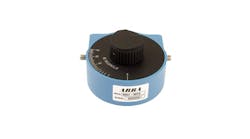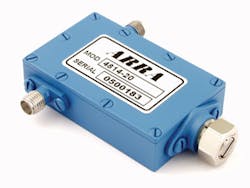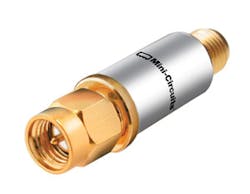This file type includes high resolution graphics and schematics when applicable.
Attenuators are found in an array of high-frequency systems, from the lowest-frequency designs through millimeter-wave communications networks. Although they perform a function—reducing signal levels—that would seem contrary to the usual design goals in an RF/microwave system, attenuators of all types serve invaluable functions in those systems. Understanding their basic parameters and options can simplify the task of selecting an attenuator for a given system.
When selecting an attenuator for an application, perhaps the most practical starting points are frequency and attenuation, because that component should provide the minimum bandwidth and attenuation required for a particular job. Attenuators are available for broad frequency ranges, such as 6 to 18 GHz, and other wide spans typically used in electronic-warfare (EW) and military communications systems. They also work in the more narrow frequency ranges, such as surrounding 2450 MHz, typically used for licensed commercial communications. Attenuation range for these devices spans from a mere 10 dB or less, up to 70 dB and greater.
Attenuators apply attenuation in a wide variety of ways, particularly because they can be specified as fixed, mechanically variable, voltage-variable, digitally controlled, and programmable models. On top of that, they come in multitude of shapes and sizes, from tiny surface-mount-technology (SMT) housings to larger coaxial and even waveguide packages.
Some suppliers, such as Mini-Circuits, supply surface-mount attenuators through a variety of different bandwidths to 7 GHz, in housings as small as 2 × 2 mm. They also offer larger attenuators for applications through 40 GHz with programmable attenuation values that can meet the needs of different circumstances, such as in test laboratories and in communications systems. When comparing attenuators from different suppliers, say, for instance, fixed 10-dB attenuators, it’s important to understand how the component choice may impact the amplitude behavior of the intended system or application.
The Devil’s in the Deviation Details
First of all, one must consider the accuracy and stability of the attenuation setting, such as 10 dB. The amount of impedance mismatch, which is usually denoted by the attenuator’s maximum voltage standing wave ratio (VSWR), can play a hand in the amount of attenuation variation in an application.
RF/microwave attenuators are specified according to the amount of attenuation deviation or flatness they will exhibit across their frequency range and across operating temperatures. The value, which in some cases can exceed ±0.5 dB, is typically a function of attenuation value and frequency, with greater attenuation variations found at higher frequencies. For a fixed attenuator, the accuracy or attenuation deviation applies to that single value, while for a variable attenuator, attenuation deviations apply to the tunable range of attenuation settings.
However, such components are also characterized in terms of insertion loss, which is the additional loss expected from using that attenuator over a given frequency range. When comparing different fixed attenuators, one should take into account both the attenuation variations and insertion loss.
Power-handling capability is another key consideration when specifying fixed or variable attenuators, since they must handle maximum power levels without any signal degradation. Many attenuators provide limits for continuous-wave (CW) and peak power levels. A drastic difference exists between the two limits because peak power is measured for a typically short pulse at a short duty cycle, as in radar systems. Typical values for a coaxial fixed attenuator might be maximum input power of 2 to 5 W CW and maximum peak power of 1 kW for short (microsecond) pulsed signals at short duty cycles (much less than 1%).
Attenuators are normally expected to appear electrically “invisible” within a system or circuit, except for their amount of attenuation. They’re often used with test equipment to bring a high-level signal under test into a suitable input range for a test receiver, such as a spectrum analyzer or an oscilloscope. To minimize impact to a measurement or other application, an attenuator will ideally exhibit low VSWR, low insertion loss, and minimal attenuation variation with frequency.
This file type includes high resolution graphics and schematics when applicable.
Continuously Variable
This file type includes high resolution graphics and schematics when applicable.
Some applications, such as those in measurement facilities, may require continuous adjustment of a power level (e.g., test signals sent to an oscilloscope). In these cases, a continuously variable attenuator makes it possible to vary a signal’s amplitude while witnessing the effects of the changes in signal power level on a system or test instrument. Of course, since the attenuation value can be varied, it’s not a matter of comparing the attenuation accuracy of a unit, but rather comparing their resettability—how precisely they can be returned to a previous attenuation setting.
For example, the 6684 model series from ARRA is a family of continuously variable attenuators for different portions of the frequency range from 2 to 18 GHz (Fig. 1). They include calibrated direct-reading dials (with attenuation values calibrated in 1-dB increments) to show the value of attenuation that has been tuned, and can be specified with as much as 100-dB attenuation in some models.
These continuously variable attenuators are able to handle 10-W average input power and 5-kW peak power in their rugged aluminum housings. The firm also offers a line of motorized variable attenuators for remote applications. These units, which consist of an integrated motor head and single-turn variable attenuator in a small housing, operate from +12-, +15-, +24-, and +28-V dc supplies.
For applications that require a more compact housing, the firm’s 4814-20 continuously variable attenuator, with a 20-dB range from 2 to 4 GHz, comes in a standard coaxial housing with SMA connectors measuring just 2.00 × 1.25 × 0.5 in. (Fig. 2). The 4814-20 promises 0.1-dB resettability across an operating temperature range of –55 to +85°C. It’s rated for 5-W average (CW) power and 5-kW peak power for short pulses, with 0.5-dB maximum insertion loss. The component, which has been qualified for military applications, achieves its attenuation in a non-contacting manner, thus ensuring wear-free performance and a long operating lifetime.
RLC Electronics, for example, offers continuously variable as well as programmable step attenuators in coaxial packages for applications through 18 GHz. The firm’s PA Series of attenuators are available for frequencies from dc to 18 GHz in either 0- to 15-dB attenuation (in 1-dB steps) or 0- to 70-dB attenuation (in 10-dB steps).
Numerous companies offer RF/microwave attenuators in SMT packaging for tight spacing on printed-circuit boards (PCBs). For example, Synergy Microwave Corp. offers a line of fixed-value attenuators in eight-pin miniature relay headers for handling as much as 0.5 W power from dc to 1500 MHz. These devices include values of 3, 6, 10, 15, 20, 30, and 40 dB with typical attenuation flatness of ±1 dB or better.
Mini-Circuits supplies fixed, variable, and programmable attenuators spanning dc to 40 GHz in surface-mount packages as small as 2 × 2 mm. The LAT-10+ attenuator is part of a line of components with fixed values from 0 to 40 dB in 0.12- × 0.10- × 0.047-in. housings. It provides 10-dB fixed attenuation from dc to 2500 MHz, with attenuation flatness of ±0.3 dB through 1000 MHz and ±0.5 dB through 2500 MHz.
The company’s line of inline coaxial fixed attenuators, such as the VAT-1+ (Fig. 3), provides 1-dB fixed attenuation from dc to 6 GHz. It’s rated for power levels to 1 W and is typically accurate to ±0.3 dB across the frequency range. Unibody construction with SMA connectors makes it easy to add to coaxial cables and systems requiring an impedance match or level adjustment.
In contrast, the firm’s ZX76-31-PP+ digital step attenuator in a compact RoHS-compliant housing offers extremely accurate attenuation over a 31-dB control range. The attenuation can be selected in 1-dB steps across a 31-dB range from dc to 2400 MHz by means of a 5-b parallel control interface. Typical attenuation accuracy is 0.2 dB for a 16-dB attenuation setting across the full frequency range. While not the extremely tiny size of an SMT attenuator, this unit and other members of its product family provide simple programmability and a flexible attenuation range for testing, for level adjustments in communications systems, and even for medical systems. Able to run on a single +3-V dc supply, it’s built for tough environments.
The number of companies offering RF/microwave attenuators of all shapes and sizes (including fixed and programmable units) is long. It includes the companies already cited, along with Aeroflex/Weinschel, Fairview Microwave, Flann Microwave, G.T. Microwave, Hittite Microwave, JFW Industries, Narda Microwave, Pasternack, and Pulsar Microwave.
This file type includes high resolution graphics and schematics when applicable.




